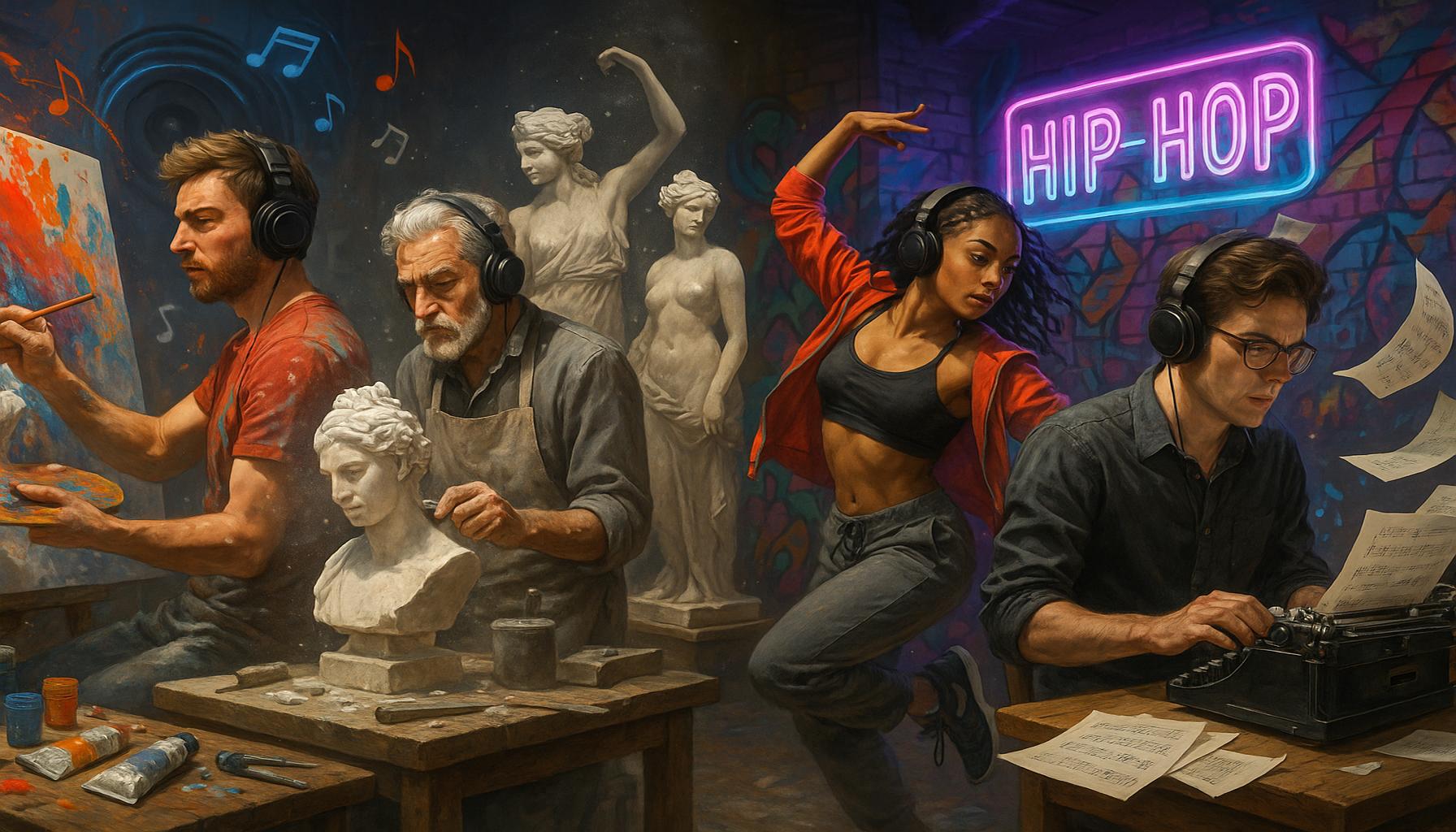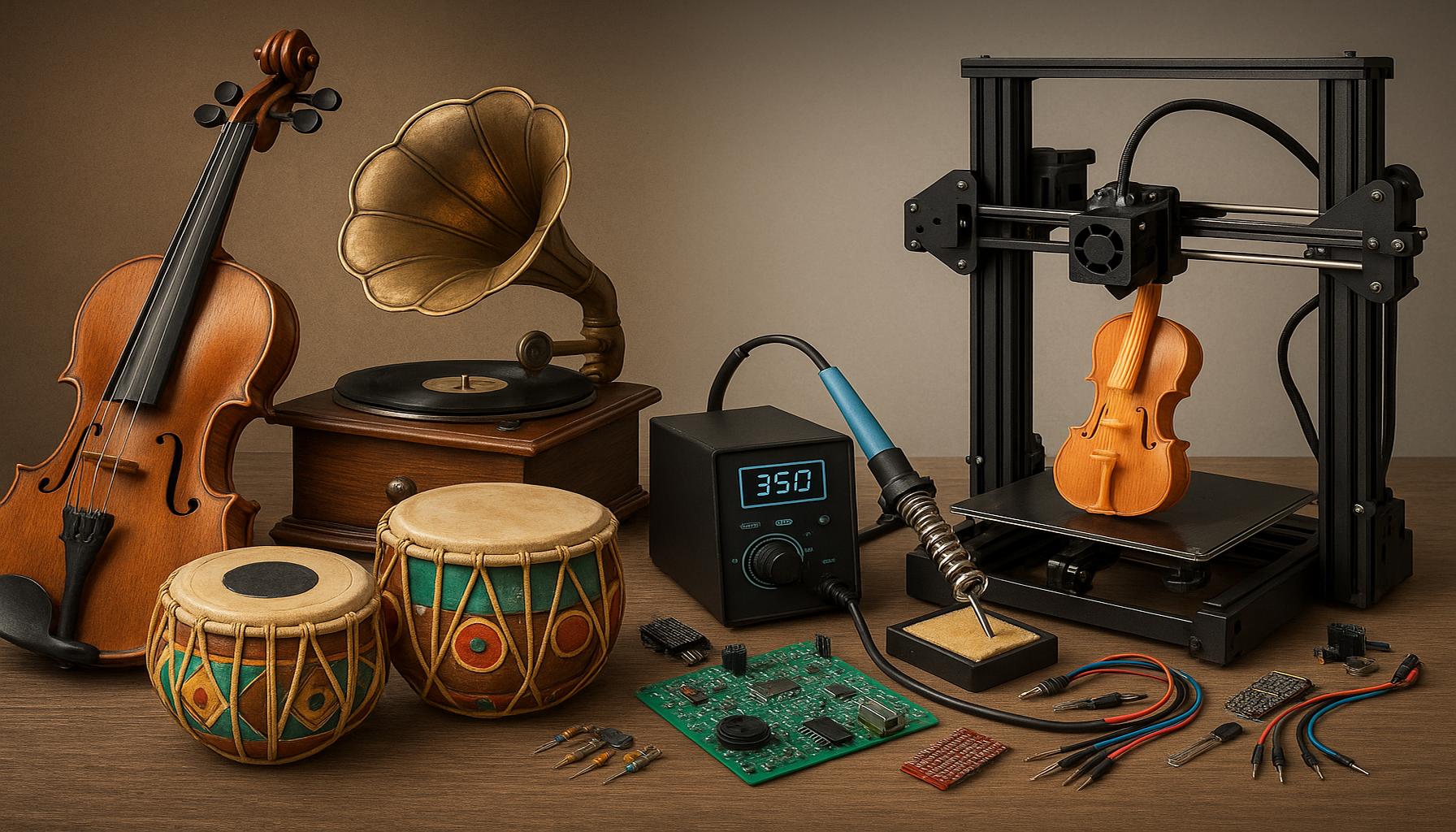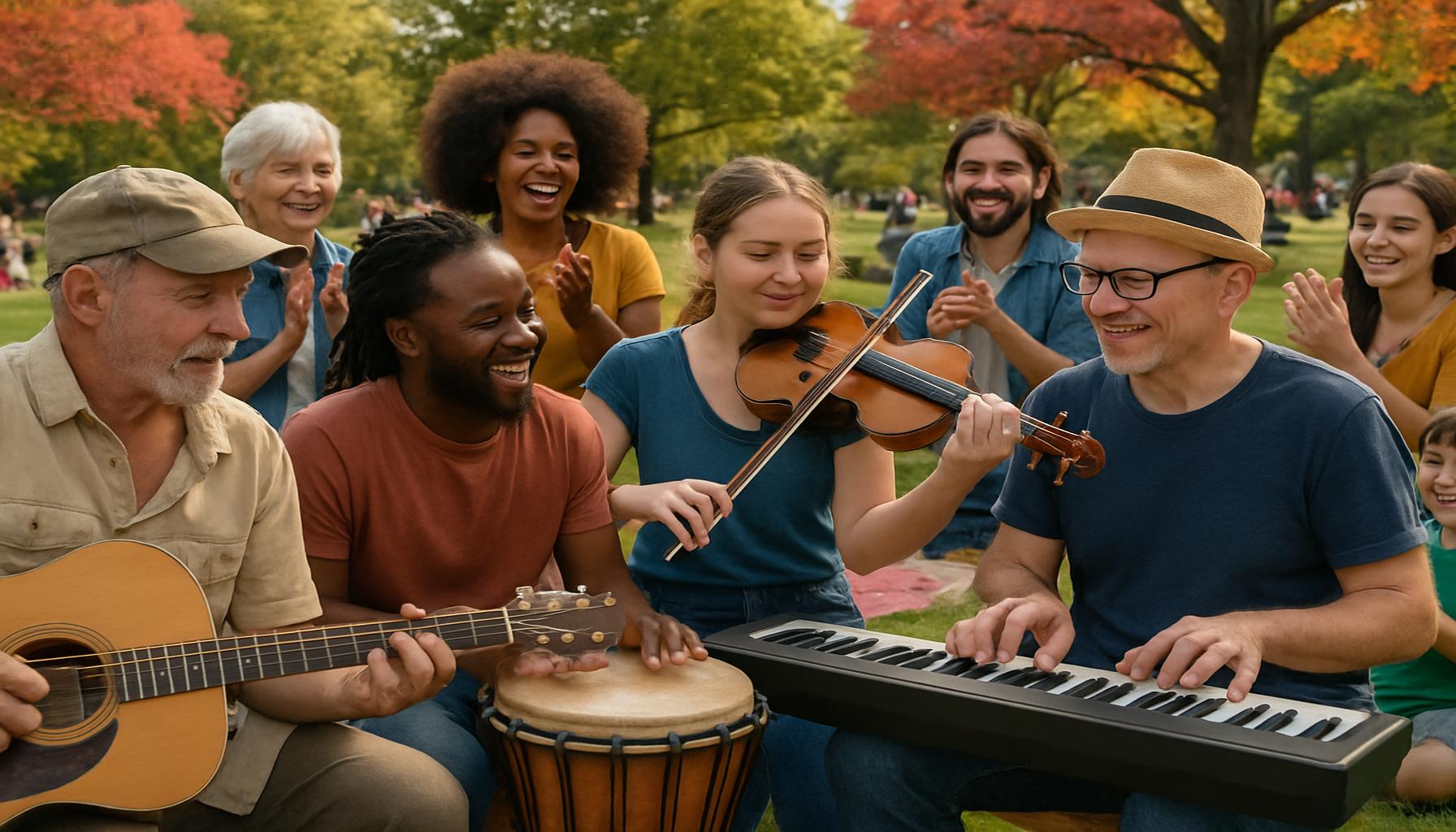How Music Genres Influence Personal Expression in Creative Hobbies

The Influence of Music on Creative Expression
Music is a powerful medium that transcends boundaries, influencing not only our emotions but also our creative pursuits. Various music genres serve as inspiration, shaping how individuals express themselves in their hobbies. From painting to crafting, the rhythm and tone of different styles can ignite passion and innovation.
Consider how different genres play a role in creativity:
- Rock often inspires bold, edgy artwork. The raw energy and rebellion of rock music encourage artists to experiment with colors and styles, resulting in dynamic paintings or sculptures that capture the spirit of freedom. For instance, the vibrant album covers of iconic rock bands like The Rolling Stones or Nirvana often reflect the artistic movements of their times, showcasing how the music itself inspires visual creativity.
- Jazz encourages improvisation in writing or performance. The spontaneous nature of jazz, with its complex rhythms and melodies, can evoke a sense of fluidity and freedom in writing. Poets and novelists often find that listening to jazz stimulates their creative thought process, allowing them to explore themes of spontaneity and experimentation in their work, akin to the way jazz musicians play with improvisational techniques during a live performance.
- Classical can evoke a sense of tranquility, influencing delicate crafts. The soothing harmonies and complex compositions of classical music, such as the works of Bach or Mozart, provide a serene backdrop for many creative endeavors. Crafts like knitting, pottery, or even calligraphy can be enhanced by the calming effects of classical pieces, allowing artisans to focus and immerse themselves in their work, leading to more refined outcomes.
As we delve deeper into these connections, the relationship between music and personal expression becomes undeniably intriguing. Research has shown that different genres can evoke specific emotions, which in turn affects the way creators approach their projects. For example, a study conducted by the University of Central Florida found that participants who listened to upbeat music while creating art reported feelings of enhanced motivation and creativity, compared to those who listened to more subdued genres.
Understanding this dynamic can open new doors for those seeking to enhance their hobbies through the power of music. By identifying which music genres resonate most profoundly with their creative processes, individuals can curate playlists that enhance their focus or inspire new ideas. This exploration not only enriches the creative experience but also highlights the profound and often underappreciated role that music plays in the realm of artistic expression.
DISCOVER MORE: Click here to uncover the psychological benefits of artistic hobbies
Exploring the Rhythms of Creativity
From the vivid swirls of paint on a canvas to the delicate strokes of a paintbrush, the connection between music genres and creativity is as varied as the forms of art themselves. Each genre carries its unique energy and emotional resonance, significantly impacting the way creators engage with their hobbies. Understanding how these influences manifest can lead to richer creative experiences, enhancing not only artistic quality but also personal satisfaction.
For many hobbyists, the first step in their creative journey often begins with the type of music playing in the background. Consider the following insights into how specific genres shape personal expression:
- Electronic music brings a futuristic and experimental approach to creation. The pulsating beats and immersive soundscapes characteristic of electronic genres can invigorate artists’ work, encouraging them to push boundaries with modern tools and techniques. Many digital artists find that the layered textures and intricate sounds of electronic music inspire innovative designs and multimedia projects, allowing for an exciting exploration of visual storytelling.
- Country music evokes storytelling and emotional depth. Renowned for its narrative-driven lyrics, country songs often inspire writers and artisans alike to draw from personal experiences. Whether through crafting heartfelt poems or creating personalized handmade gifts, the emotional storytelling found in country music resonates deeply with those working on projects that celebrate life experiences and relationships, making it an authentic backdrop for creative hobbies.
- Hip-hop emphasizes rhythm and wordplay, inspiring lyricism and dynamic visuals. The genre’s emphasis on storytelling through clever word choices encourages writers and content creators to reflect upon their personal journeys. Street artists and graphic designers often channel the bold, outspoken spirit of hip-hop, translating its high energy into striking visuals and compelling narratives that resonate with their communities.
In addition to the artistic styles promoted by different genres, the psychological impact of music on creativity is not to be overlooked. Research conducted by the University of Toronto highlights that listening to upbeat and energetic music specifically can lead to increased creativity and decreased feelings of inhibition among creators. This finding suggests that the music we choose not only sets the mood but also alters the way we engage with our hobbies.
Many hobbyists are now curating personalized playlists that align with their artistic pursuits. By selecting tracks from genres that resonate with their creative goals, individuals can unlock new dimensions of expression. This practice of pairing music with hobbies is becoming increasingly popular, with creators exploring how different tempos, beats, and lyrics can enhance their craft. It opens doors for experimentation and innovation, encouraging creators to step outside their comfort zones.
As we further investigate this compelling relationship, it becomes clear that music genres do not merely serve as background noise; they are essential catalysts that fuel inspiration and creativity. Understanding how to harmonize your creative expressions with music can lead to transformative experiences, and in the following sections, we’ll delve deeper into specific genres and their profound impacts on various artistic practices.
The Dynamic Role of Music Genres
Music genres serve as a transformative canvas for personal expression in various creative hobbies. Each genre embodies distinct emotions, rhythms, and cultural backgrounds, influencing how individuals channel their creativity. For instance, classical music often evokes a sense of serenity and precision, making it an ideal backdrop for painting or writing poetry, encouraging meticulous attention to detail. On the opposite end, the upbeat tempo of rock music can inspire spontaneity and boldness in activities like dance or graphic design. Furthermore, the fusion of diverse genres can lead to innovative artistic expressions. An artist drawing inspiration from jazz may integrate improvisational elements into photography, creating candid moments that capture the essence of spontaneity. Similarly, hip-hop culture has profoundly impacted fashion, with its bold, often unconventional styles encouraging self-expression that defies societal norms.Exploring how various musical styles inspire different creative pursuits not only broadens artistic horizons but also prompts individuals to delve deeper into their psychological responses to music. This exploration can unveil connections between music and identity, illustrating how personal experiences shape artistic expression. Additionally, participating in communal activities such as dance or theater often associated with specific genres fosters a sense of belonging and community. During these experiences, individuals not only express their individuality but also find common ground with others, strengthening social bonds through shared passions. The interplay between music and hobbies is multifaceted, inviting individuals to experiment and redefine their creative processes continually. Whether it’s through the slow, emotive strains of blues during a crafting session or the energizing beats of EDM while working on DIY projects, the influence of music genres on personal expression opens a vibrant dialogue between sound and creativity, encouraging ongoing exploration and innovation in the arts.
| Music Genre | Influence on Creative Hobbies |
|---|---|
| Classical | Encourages meticulous attention to detail |
| Rock | Promotes spontaneity and boldness in creative expression |
| Jazz | Inspires improvisation and innovative artistic expressions |
| Hip-Hop | Influences fashion and self-expression through bold styles |
Exploring these dynamics leads to a richer understanding of how music genres not only shape personal practices but also reflect broader societal trends in creativity.
DISCOVER: Click here to learn more about the digital art evolution
The Sound of Artistic Flow
As we delve deeper into how music genres shape personal expression in creative hobbies, we uncover intriguing patterns that extend beyond individual genres. The interplay of rhythm, melody, and emotional undercurrents informs not only the creative process but also the final products of artistic endeavors. This ongoing dialogue between music and creativity affects a broad spectrum of hobbies, from painting to writing, crafting, and beyond.
Consider the jazz genre, which exemplifies spontaneity and improvisation. For many artists, the unstructured and fluid nature of jazz encourages them to explore freedom in their creative processes. As jazz musicians often push the boundaries of composition through improvisation, visual artists may find themselves adopting a similar ethos. They might experiment with abstract styles, letting the music guide their brushstrokes and color choices. This kind of artistic expression allows for a personal connection to the artwork, enabling the artist to portray complex emotions and ideas that resonate with their audience.
Rock music, with its high energy and rebellious spirit, can have a profound influence on those engaged in more dynamic forms of art. Whether it’s creating edgy graphic designs or crafting innovative DIY projects, the driving force of rock’s heavy guitar riffs and powerful vocals often invigorates creators. This energetic backdrop enables hobbyists to channel their enthusiasm into bold color palettes and striking shapes, resulting in pieces that resonate with the raw energy of the genre.
Additionally, the impact of classical music on creative hobbies should not be overlooked. Known for its structured compositions and emotional depth, classical music often inspires a more contemplative and disciplined approach to art. Writers may find themselves lost in the rhythm and flow of a symphony, drawing inspiration for narratives that explore complex themes. For painters, the grandiosity of orchestral pieces can lead to the creation of expansive landscapes and intricate detail work, as the music pushes them to reflect on vast emotional and artistic landscapes.
Moreover, there’s a burgeoning trend of creators using world music to enrich their artistic expressions. Incorporating diverse cultural sounds, rhythms, and instrumentation can broaden the scope of creativity and inspire cross-cultural dialogues in art. For instance, a mosaic artist might draw from African drumming patterns, incorporating geometric designs and color schemes that reflect the essence of the music. This fusion of influences not only celebrates diversity but also creates a rich tapestry of artistic expression.
Furthermore, technology plays a pivotal role in how these musical influences are integrated into creative hobbies. Streaming services and platforms like Spotify and Apple Music allow hobbyists to curate tailored playlists that complement their artistic processes. Many artists are finding that music not only enhances their focus but offers a consistent muse, guiding both style and emotion in their work. By searching for playlists that align with specific genres, creators can unlock new avenues of expression tailored to their tastes and objectives.
As we venture further into the realms of creativity shaped by music, it becomes increasingly evident that the marriage of music genres and personal expression is not just a surface-level interaction. Instead, it forms a profound connection that shapes not only individual creativity but also the broader cultural landscape of artistic hobbies. The rhythms, beats, and emotions encapsulated in music continue to serve as essential foundations for unique and personal expressions. This exploration reveals how the act of creating art is inherently collaborative—between the creator and the musical influences that shape their journey.
DISCOVER MORE: Click here to learn how music can enhance your mental well-being
Final Thoughts on the Symphony of Creativity
In conclusion, the intricate relationship between music genres and personal expression in creative hobbies illuminates the powerful ways in which sound shapes our artistic journeys. As we have explored, genres like jazz, rock, classical, and world music each provide unique frameworks that can inspire, inform, and transform the creative process. Through experiments with rhythm, melody, and cultural influences, artists discover not only their voices but also avenues for deeper emotional expression.
The ability to tailor playlists and curate soundscapes via technology further enhances the creative experience, allowing artists to align their moods and intentions with the music that resonates with them. This continuous exploration leads to vibrant artistic outputs that reflect the nuances of individual experiences and societal narratives, demonstrating that creativity is indeed a reflection of our environment and influences.
Ultimately, the dialogue between music and creativity fosters a rich landscape for personal expression, encouraging creators to experiment without boundaries and engage with their art on a more profound level. Whether it’s through the spontaneous improvisation of jazz or the structured elegance of classical music, hobbyists are invited to discover how their chosen sounds can sculpt their artistic voices. As this dynamic interaction continues to evolve, it reminds us that the essence of artistic expression is rooted in connection—between ourselves, our inspirations, and the rich tapestry of human experience that music embodies.


